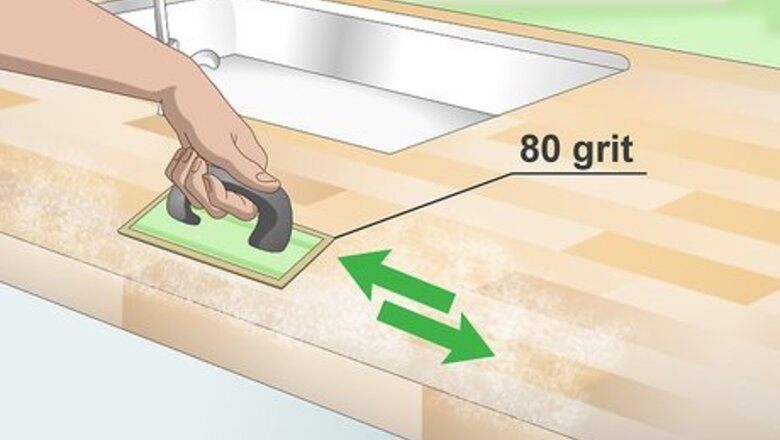
views
- Sand the butcher block with 80-grit and 150-grit sandpaper. Then, apply an even layer of wood conditioner and let it dry overnight.
- Then, apply a thin layer of mineral oil, oil-based stain, or water-based stain on the wood, following the wood’s grain. Let the stain dry before recoating.
- Seal the butcher block with 2-6 coats of tung oil or Waterlox for a food-safe option. Let the wood dry for 24 hours between each coat.
Sanding the Butcher Block
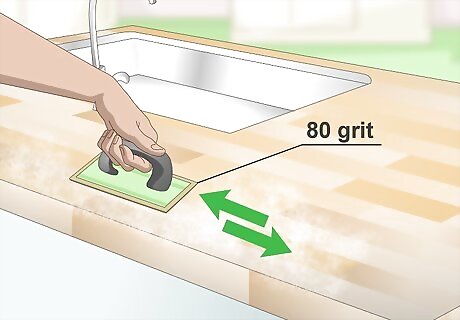
Sand the wood with 80-grit sandpaper. Sanding the butcher block with coarse sandpaper removes any existing scratches, stains, and varnishes on the wood’s surface. Just sand along the grain of the wood using long strokes. For your safety, wear a respirator mask and safety goggles as you work to prevent the dust from getting into your lungs or eyes. The grain of the wood are the distinct lines that run along the wood. Feel free to use a sanding block or an electric orbital sander.
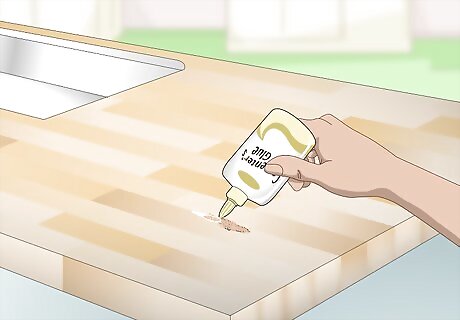
Fill any cracks in the wood with sawdust and wood glue. Collect the sandpaper dust on the butcher block and mix it with enough wood glue to form a thick, putty-like consistency. Then, spread the putty into any cracks or marks with your fingers or a wooden craft stick. Let the homemade putty dry overnight. Alternatively, fill the wood cracks with wood putty or filler sticks.
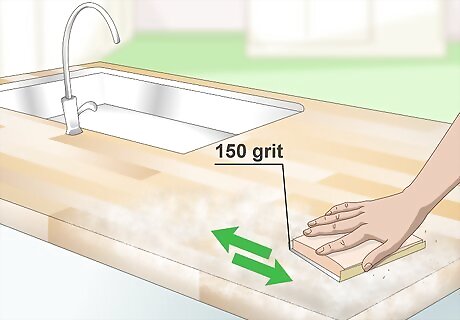
Sand the wood with 150-grit sandpaper and wipe off the dust. Fine-grit sandpaper removes any leftover marks and smooths the wood down for a more even staining. Simply sand the butcher block using long strokes in the same direction as the wood grain. Then, wipe off the sandpaper dust with a clean tack cloth, rag, or paper towel. Alternatively, vacuum up the dust and debris.
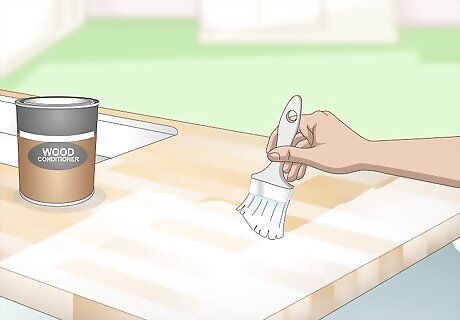
Brush on wood conditioner and let the butcher block dry overnight. Wood conditioner soaks into the butcher block to help prevent your stain from looking blotchy. Just use a 3-inch (7.6 cm) paintbrush to apply an even layer of conditioner on the butcher block using long, even strokes in the direction of the wood grain. If you're using a water-based stain, use a water-based conditioner. Likewise, if you’re using an oil-based stain, use an oil-based conditioner.
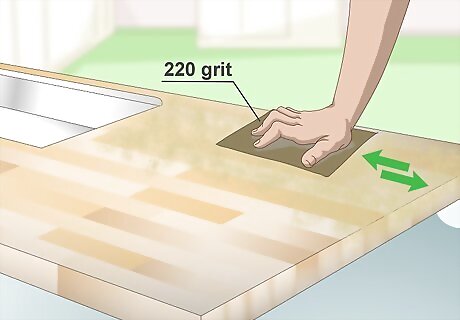
Sand the butcher block with 120-grit sandpaper and wipe up the dust. Go over the entire surface of the butcher block with 120-grit sandpaper, or finer (150-220-grit), to remove any bumps or spots of discoloration.
Staining the Butcher Block
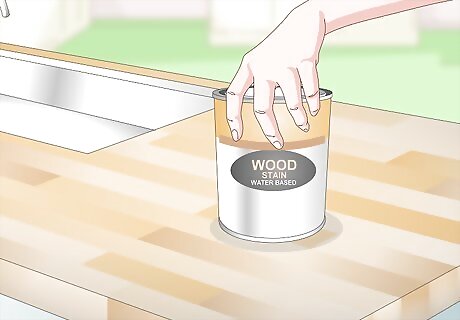
Use mineral oil, or choose an oil or water-based stain. If you plan to prepare food directly on the butcher block, use mineral oil. It is a food-safe option that adds a natural sheen to the wood. If you don’t plan on preparing food on the butcher block and you want to change the wood color, opt for an oil or water-based stain. Oil-based stains are longer-lasting, more resistant to water and stains, and easier to apply while water-based stains dry quicker and are more environmentally friendly. When you stain with mineral oil, you have to reapply it once per month. This keeps the butcher block from drying out and cracking. Some stains, like Watco Butcher Block Oil + Stain are food-safe and provide color. Choose a stain color that compliments your kitchen cabinets, backsplash, and walls. Bring home several stain samples to see what color you like, like a dark, walnut color, a reddish cherry color, or a light, pine-colored stain.
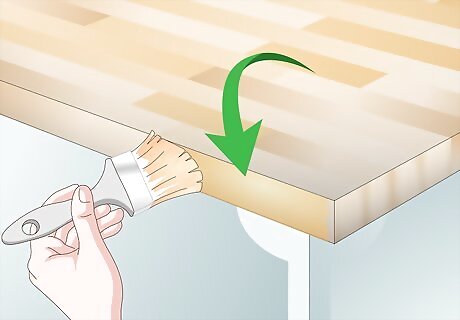
Test the stain on the underside of the block and let it dry for 2 hours. Use a 3-inch (7.6 cm) paintbrush to apply an even line of stain on a hidden part of the butcher block. Then, wipe the stain with a clean cloth. After 2 hours, look at the stain to see if you like the color and finish. If the wood has an even, consistent tone and the stain brings out the texture of the wood grain, you’re ready to stain the entire counter! Use a clean rag to apply the stain instead of a brush, if you prefer. If you have any spare wood from the butcher block, test the stain on that instead. If the stain looks blotchy or has an uneven tone, use a different color or brand of stain.
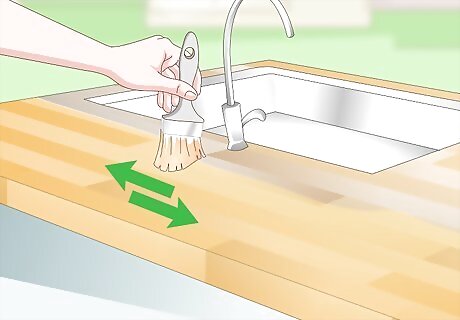
Apply the stain in a thin, even layer in the direction of the grain. Dip your paintbrush or rag in the can of stain and slide it against the side to remove excess stain. Just work in small sections and apply the stain using long, even strokes that go in the direction of the wood grain. For your safety, work in a well-ventilated area. Turn on a fan, open the windows, or wear a respirator mask so you don’t breathe in the harsh fumes. Wear gloves, an apron, and goggles to prevent the stain from splattering on your skin. Make sure to stain the top, sides, and bottom of the butcher block if it’s visible.
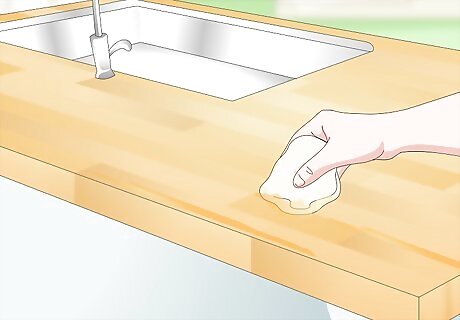
Wipe off the excess stain with a clean rag immediately. Work in the direction of the wood grain to remove any excess stain sitting on top of the wood. This helps even out your application and prevents the stain from drying splotchy. Or, leave the stain on the wood for no longer than 15 minutes before wiping it off. The longer you leave it on, the darker the stain appears.
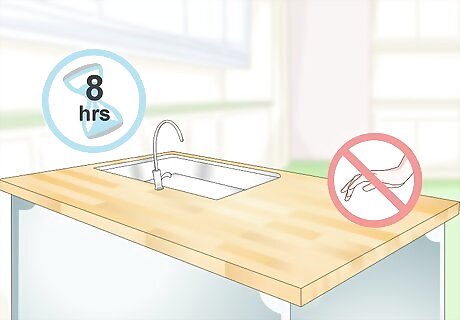
Let the stain dry for 1 to 4 hours, or according to the can instructions. Read the back of the stain to find out how long it needs to dry between coats. This can range anywhere from 1 hour to 48 hours, depending on the stain you’re using. Avoid touching or setting any objects on the wet stain during this time.
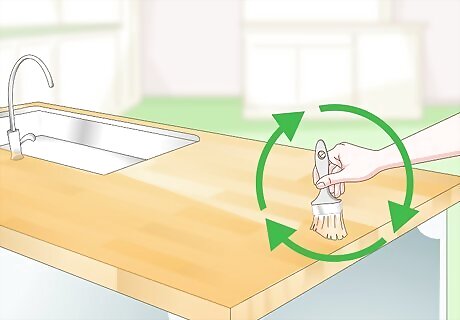
Apply 1 to 2 more layers of stain and let the wood dry overnight. If you want a darker butcher block, apply a second thin layer of stain, working in the direction of the grain. Wipe off the excess stain and wait for it to dry according to the can instructions before applying more coats. If your butcher block feels rough to the touch, sand it with 220-grit sandpaper or a brown paper bag in between each stain application. When you’re satisfied with the color of the butcher block, let it dry overnight.
Sealing the Butcher Block
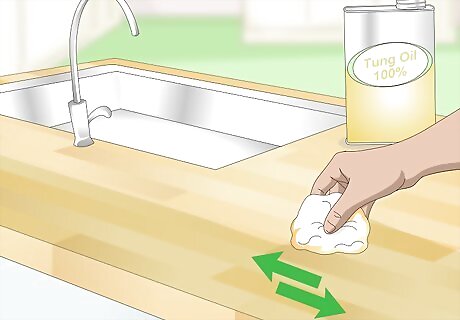
Apply tung oil or Waterlox on the dry butcher block. Both tung oil and Waterlox are food-safe sealants that protect your butcher block from water, stains, and damage. Just dip a clean paintbrush or rag into the sealant and apply it onto the wood in long, straight strokes that move in the direction of the grain. Then, wipe away excess oil with a clean rag. If you used mineral oil to stain the butcher block, you do not need to seal the wood. Mineral oil acts as both a stain and sealant. If you don’t plan on preparing food directly on the block, use polyurethane. Just use an oil or water-based formula depending on the stain you used. Polyurethane typically provides more durability and greater water resistance than tung oil.
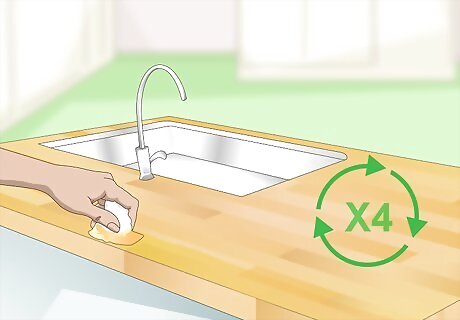
Let the sealant dry for 24 hours, then apply 2 to 6 more coats. Wood is susceptible to water and damage, so it’s important to apply multiple layers of sealant to protect it. Just allow the first coat to dry for 1 day. Then, dip a brush or rag in the sealant, apply it along the wood’s grain, and let it dry for 24 hours between each additional coat. If desired, use 220-grit sandpaper, or finer, to smooth out the sealant in between each coat. Warning: Separate your used rags and brushes and leave them outside to dry completely before disposing of them. Oil-based sealants can spontaneously combust when they’re left in a wet pile.
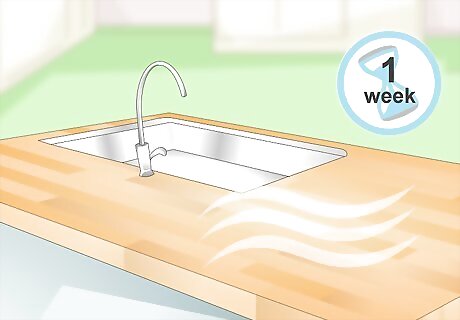
Let the butcher block cure for 7 to 14 days. Sealants take time to soak into the wood and completely dry, even if your counter feels dry to the touch. Just avoid using your counter for 7 to 14 days to give the wood time to cure.
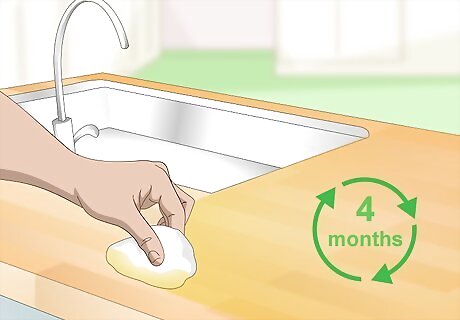
Reseal the butcher block about once per month. Tung oil and Waterlox dry out over time, which can leave your wood vulnerable to cracks and damage. Just reapply either sealant about once per month, or when your counter starts to look faded or dry. Additional coats don’t need a full week to dry. To be on the safe side, though, give each layer 3 to 4 days to cure before using the countertop. Polyurethane sealant typically needs to be reapplied every 1 to 2 years, or when it starts to look dull and faded.
















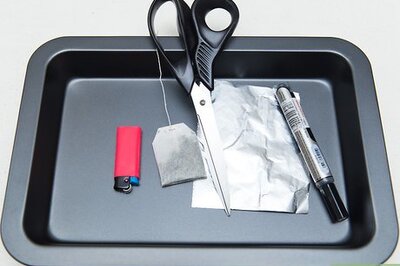



Comments
0 comment